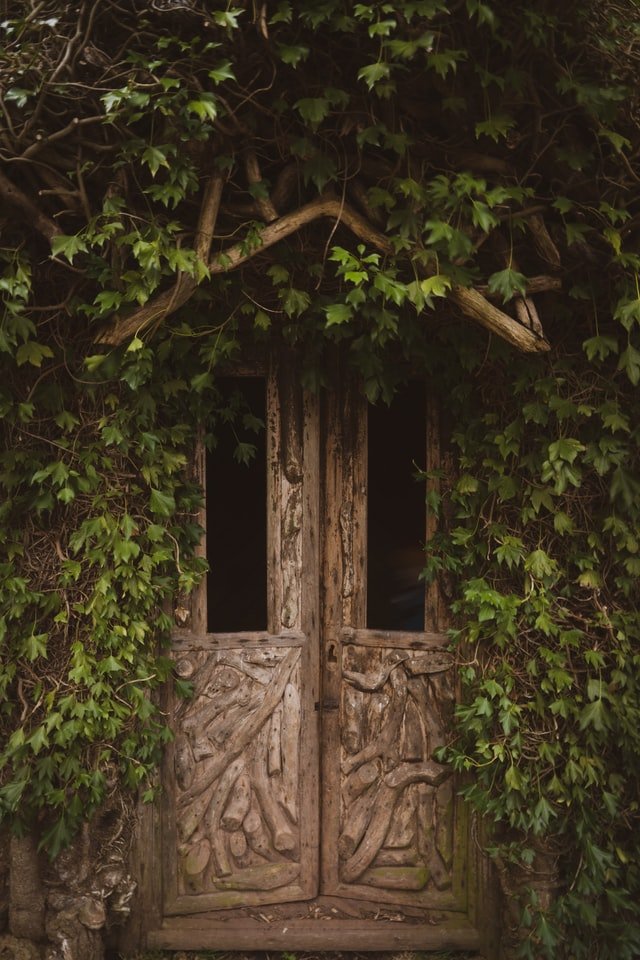Ivy is a vine that winds its way up trees, stone walls, and buildings. It is a strong plant that continues to live even after its host has died. The Celtic Month of Ivy, (September 30 - October 27) is a time associated with resilience, growth, and spiritual exploration.
This is a season of deepening autumn: leaves fall, nights lengthen, and the earth prepares for winter. Symbolically, it’s a time when we begin to let go of what no longer serves us, yet hold fast to the strength that will carry us through the darker months.
Ivy, also known as Gort, is the eleventh month in the Celtic Tree Calendar. It is represented by the Ogham letter G ᚌ [ɡ]
For modern pagans, ivy invites us to reflect on persistence, the interconnectedness of life, and the way we can continue to grow even when times are challenging.
What a beautiful door!
Ivy growing on a building. Ivy is often considered parasitic. We can also think of that as resilient! Photo by Jonny Gios.
Ivy And conservation
There are fifteen species of ivy that are native to Eurasia and northern Africa but have spread to the Americas where it is considered an invasive species. Ivy can smother trees, killing them, and thus damage ecosystems. For gardeners and pagans outside Europe, it’s wise to honor ivy symbolically while also being mindful of ecological balance. For this article, we are referring to English Ivy.
In Europe, where it is native, common ivy (Hedera helix) provides important habitat and food. Its late-season flowers feed bees, hoverflies, and other pollinators when few other blossoms are available. Its berries ripen in winter, offering nutrition for birds like thrushes and wood pigeons.
Ivy-covered walls and trees provide excellent roosting and nesting spots for birds, bats, and insects. The dense leaves act as insulation, creating microhabitats.
While ivy is not a tree it still has an important place among the other months of the year. Ivy is a vine that depends on trees and other structures to support it. A member of the Ginseng family, it can grow a hundred feet from its roots.
Ivy reminds us that life goes on. It is a strong plant that can and will grow on almost anything. It teaches us that the cycle of life and death continually renews. Ivy keeps its leaves long into the fall and is quick to leaf out in the spring. Ivy is a hardy plant and people with shady gardens often plant it as a ground cover.
History
Ivy was dedicated to the Roman God Bacchus. Poets and philosophers as well as Bacchus wore a crown of ivy. Bacchus was known for his revelry and ivy was believed to cure intoxication.
Learn more about the party boy Bacchus in our article The Roman Festival of Bacchus.
Ivy is associated with the Celtic Lunar Goddess, Arianrhod, Goddess of Reincarnation, fertility, and childbirth. Arianrhod represents good luck as well as the mysterious and mystical.
There is an element of Ivy that represents death. In American folk myths, it’s unlucky to give or be given ivy because it symbolizes death. Ivy frequently grows in cemeteries which may be part of why it’s correlated with death.
Related Elements
Planet: Moon, Saturn
Element: Water
Symbolism: Fertility, Protection, Healing
Stone: Opal
Color: Indigo
Bird: Lark, Swan, Swallow
Deity: Ariadne, Artemis, Arianrhod, Dionysus, Bacchus, Osiris
Flowers meaning: friendship, marriage, assiduous to please
Deities For the Month of Ivy
Arianrhod
Arianrhod the Welsh goddess of the moon, stars, fate, and feminine mysteries. She supports divination work and is often invoked during rites of passage. She is written about in the Mabinogion, a medieval collection of Welsh tales.
In these tales she places a series of geasa (taboos or conditions) on her son Lleu, refusing to name him, arm him, or allow him a human wife. These acts tie her to the role of fate-weaver—she decides the destiny of others, much like the Norns in Norse mythology.
Ivy and Arianrhod both embody endurance, fate, and the mysteries of life’s cycles. Ivy roots us in the earth with resilience, while Arianrhod guides us through the stars with sovereignty and destiny. Together, they form a bridge between the green world and the cosmic wheel.
Dionysus/Bacchus
One of ivy’s strongest mythological ties is to Dionysus (Greek) or Bacchus (Roman), the god of wine, ecstasy, and transformation. He was often depicted crowned with grapevine and ivy, the twin plants that twine and celebrate life.
Ivy symbolized the god’s duality—wild abandon and deep, unbreakable vitality. Ancient worshippers used ivy crowns in festivals, believing it to protect them from drunkenness while still allowing them to partake in revelry.
Osiris
Interestingly, ivy also shows up in Egyptian mythology. It was introduced to Egypt later, specifically during the Greco-Roman period.
Osiris, the god of the underworld and rebirth, was associated with evergreen plants like ivy as symbols of eternal life. Priests wore ivy in rituals for immortality, suggesting its spiritual symbolism was shared across cultures.
Celebrating the Month of Ivy Today
There are many ways modern pagans can honor ivy during its month. Here are some meaningful practices:
1. Create an Ivy Altar
Decorate your altar with ivy leaves (real or symbolic), green candles, and a chalice of water or wine. Pair ivy with grapevine, holly, or oak to honor its connections with balance and the natural cycle. You might also add images of deities like Dionysus, or simply honor the energy of resilience.
2. Meditate on Resilience
Use ivy imagery in meditation. Picture yourself as ivy, rooting deeply and climbing upward, finding strength and support in your connections. This is especially powerful during times of personal struggle or transition.
3. Celebrate Community
Host a small gathering with friends or your pagan circle. Share food, wine, and stories. Like ivy that twines and connects, use this month to strengthen your bonds. Craft ivy wreaths or garlands together as a symbol of unity.
4. Seasonal Observances
The Month of Ivy overlaps with the pagan festival of Samhain, the time when the veil between worlds thins. Incorporating ivy into Samhain rituals reminds us of the continuity of life and death, and the eternal bonds that connect us to ancestors and spirits.
5. Family Activity
Take a nature hike and look for ivy growing in yards, on buildings, and in the woods. Carefully and quietly peek under the leaves to look for critters. Thank the ivy for giving them a home and a meal!
Magic
Magic and Spells with Ivy
Protection Spell: Hang ivy above doorways or weave into charms to guard your home against negativity.
Love and Fidelity Charm: Braid ivy with red thread and place it under your pillow to strengthen romantic bonds.
Growth and Opportunity Ritual: Write your goals on a strip of paper, wrap it in ivy leaves, and place it on your altar to encourage steady growth.
Ivy is resilient, strong, and persistent. It is a good plant to assist you in prophesy or divination.
This month is ideal for doing self-healing, protection, and cooperation work. Banish negativity and remove anything toxic from your life.
Ivy is also a good month which to bind yourself anew with a spouse or lover. Ivy was often carried by brides and scattered at their feet during the wedding.
Ivy reminds us to control our power. Let’s not forget Poison Ivy from the Batman series who used her powers to terrorize the world. Ironically, her goal was often good. She sought to save endangered plants while destroying humans. She represents both the powerful and the sinister in nature.
Learn about pagan celebrations, spells , and animals that are part of October
House Protection Spell
This is a perfect spell to do after you have cleansed your home by smudging. Read about smudging here.
Use the power of ivy to protect your home from negative influences.
Materials:
A black candle
Ivy vines
Steps:
Place the black candle on your altar or a table in the center of the home.
Light the candle and say, “I call upon the spirits of this home to come in peace.”
Place the ivy vines on the floor in a circle.
Step into the circle and raise your arms in welcome.
Face north and say, “Spirits of the Earth protect me.”
Face east and say, “Spirits of air protect me.”
Face south and say, “Spirits of fire protect me.”
Face the west say, “Spirits of water protect me.”
Take the vines that formed your circle and place them in the corners of your home.
Symbolism
Ivy’s Symbolism for Modern Pagans
Resilience and Survival: Ivy thrives in shade, clings to surfaces, and stays green through winter. It represents persistence, the will to grow, and the strength to endure challenges.
Connection and Community: Its tendrils remind us of relationships, family, and the networks that sustain us spiritually and emotionally.
Immortality and Spiritual Growth: As an evergreen, it symbolizes the eternal cycle of life and soul survival beyond death.
Binding and Fidelity: Ivy’s clinging nature represents bonds, devotion, and lasting love.
Celtic and British Isles Connections
In the Celtic world, ivy is less directly tied to a specific deity but strongly connected to the Goddess archetype. Its evergreen nature linked it to themes of rebirth and the feminine principle of endurance. In folk customs across the British Isles, ivy was often paired with holly in winter rituals, symbolizing the balance of masculine and feminine energies.
In England and Ireland, ivy was sometimes used in wedding ceremonies, woven into wreaths or garlands to symbolize fidelity and eternal love. This association comes from its clinging, binding nature—a reminder of devotion and bonds that hold fast.
Healing
Hippocrates was the first to write about using ivy to prevent intoxication, reduce swelling, and as an anesthetic.
Modern herbalists use ivy as an anti-inflammatory and to treat arthritis. Ivy contains Saponins which are a bitter-tasting form of triterpene glycosides.
Also, the word saponins does look like the word soap. They form foam when agitated.
According to WebMD ivy has been used traditionally as a cough expectorant and for bronchitis. However, it can have side effects and cause a rash inside the mouth. Caution is needed when using it so consult your doctor.
Ivy Houseplant and Pets
Ivy makes a nice houseplant but can cause illness in pets. Ivy grows well in pots and is a low-light plant. Ivy is in the family Hedera family. There are about ten species in the Ivy family.
English Ivy (Hedera helix) can cause vomiting and gastrointestinal upset in cats and dogs.
However, Sweedish Ivy is actually not an Ivy. Its scientific name is Plectranthus australis. Sweedish Ivy is not toxic to pets.
Take Away
Enjoy the Month of Ivy by being strong and resilient!
Author, Ame, is a lifelong pagan and environmental educator. Learn more about us here.








